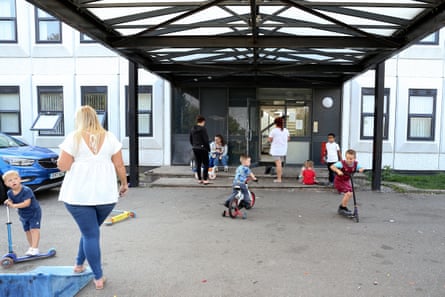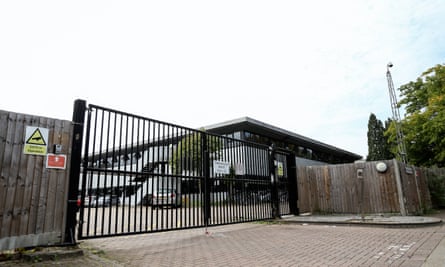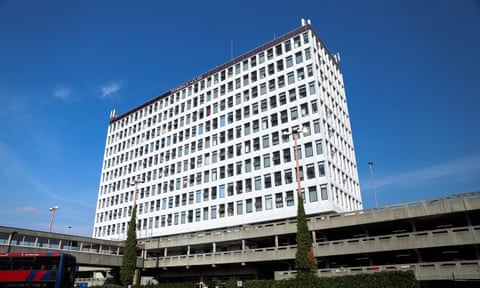“I can’t work” says Katya. One reason she can’t work is that it takes her 40 minutes to walk to the nearest available school from her housing block in Harlow, Essex, and 40 minutes back, which means that she spends the best part of three hours every day ferrying her young children to and fro. Shops are also a long walk away, apart from a petrol station where you can buy milk and bread for above-average prices. She can’t afford broadband or the devices that access it. “We are really isolated.”
Her flat is small – “if you open the door you hit the bed” – freezing in winter, boiling in summer, and prone to mould. Being on the ground floor, she doesn’t dare open her windows at night. There have been drug dealing and knife fights in her block. There is “always shouting and arguing”, she says. “The children are frightened.”
Her neighbours have similar experiences. Their block is privately owned, but they have been placed there by local authorities desperate to find anywhere to house them. Some have lived there for two or more years, transplanted from London boroughs: it might take two or more hours, and cost £50 or more to return to see friends and family. They have minimal storage space. Bicycles jam the narrow corridors, which would be a hazard in a fire, because, as the residents say, there is nowhere else for them to go. The only outdoor space where the children play is a patch of grass around the refuse bins, or a car park at the front. At one end trucks trundle back and forth, serving a depot for heavy construction machinery at the back. One boy got his head stuck under a truck, mercifully stationary at the time. Pandemic and lockdown have not made their hemmed-in lives any easier.

A big reason why they have these problems is that they live in a place that was never meant for human habitation, a converted office building in a commercial zone. It is a long, low, pre-cast concrete structure, in a once-fashionable egg-crate style, whose big repetitive sheets of glass have nothing domestic about them. Harlow was one of the new towns created after the second world war, laid out on garden city principles, partly to provide urban slum dwellers with decent homes amid ample space and greenery. Those ideals have been grimly perverted: homes in Harlow were never meant to be like Katya’s. We have approached the company who own Shield House, as this building is called, for their comment, without success.
Shield House is just one example of “permitted development”. It is an outcome of a government experiment in deregulation, which allows homes to be made out of old offices and shops without planning permission, that has been going on for some years. An estimated 65,000 flats have been made in this way. The experiment has been catastrophic in several significant respects, but the government has recently decided to double down on it, expanding their policy such that office blocks may now be replaced with entirely new buildings without permission. This means that undersized and badly planned and located flats can now be realised at a larger scale. This is the famous definition of insanity – doing the same thing over and over and expecting different results – applied, with devastating effects, to the places where people live.
Other such conversions have had other problems. At one, Templefields House, also in Harlow, trucks thunder past all day long, which can make trips out a miserable and potentially dangerous experience. “It was just a horrible environment,” says a former member of staff there. If people didn’t have drug problems when they arrived, he says, the amount of dealing inside the densely populated block meant that many of them soon did. “There were two instances where babies were taken off their mothers because they had overdoses.” There were “postcode wars within Templefields, so it was like I’m from Lewisham don’t look at me, I’m from Harlow don’t look at me. All in one building and there’s young children living there.”
In Terminus House, a 14-storey concrete former office slab in the centre of Harlow that has achieved national notoriety, a BBC Panorama programme reported on mothers and children living in tiny studio flats, on gang fights in the narrow corridors and lift lobbies that left blood on the walls.
“It’s like an open prison,” says Gary, who lives there now. “I’ve been in prison so I know. Here you’ve got your own key and that’s about it. There was a room inspection yesterday.” He is from Newham in London, where the council “kinda bargained me off with: ‘You’re going to have your own kitchen and bathroom.’” The move was “hard, hard, man, very. I don’t know no one, there ain’t much to do round here artistically and culturally. It’s a different kind of area, hardcore Essex.”

Harlow council has taken what steps it can to prevent more than the 12 such conversions it already has. But they are sprouting all over the country. One study found a flat in Derby of 10 square metres. In Bradford homes have been formed out of a block placed between a roundabout, a dual carriageway, a car park and a bus station. In the worst cases flats have been built without windows. There have been recent reports of shops made into “shoebox” flats in Southampton. In Bristol 200 or so of the city’s homeless are being moved into an office block converted by Caridon Property, the company responsible for Terminus House and Templefields House, but not Shield House. It also owns several similar projects in the Sussex new town of Crawley and the south London borough of Croydon.
The main role of permitted development was once to ease the path of conservatories, small domestic extensions, garden sheds, and other uncontroversial works. But over the past few years the government (in England only, as the other nations of the union have devolved planning regimes) has turned it into a machine for driving up housing numbers, no matter how drastic the effects on people’s lives.
In three reports in 2011 and 2012 the rightwing thinktank Policy Exchange had a prolonged lightbulb moment. What, they asked, if permitted development rights were extended, so that they would allow worn-out office buildings to be converted into housing, without the need for full planning permission? Since seeking planning permission can be an inefficient, expensive, risky and sometimes capricious process, there were attractions to the idea. Why not cut red tape and unleash the power of a deregulated market, to release a plentiful supply of residential units that would be relatively cheap, whether or not they were especially cheerful? “No one is going to mind if an office becomes a home,” said Policy Exchange. “We need to systematically change the planning system. Our current planning system, designed as part of a socialist utopia in the 1940s, has to be modernised for a 21st-century economy.”
Alex Morton, one of the authors of the reports, became a special adviser on housing to David Cameron. Nick Boles, the founding director of Policy Exchange, became minister of planning. In 2013 the thinktank’s idea became government policy, at first temporarily, then permanently from 2016, with exceptions for major business districts in London, Manchester and a few other places. “It has been a big success,” Boles later claimed, “with a huge number of residential units created.”

That was not the conclusion of a report commissioned by the Ministry of Housing, Communities and Local Government, carried out by University College London and the University of Liverpool, published last July. Rather than Boles’s “success” it identified several failings: conversions under permitted development, for example, were likely to create poor homes “in relation to a number of factors vital to the health, wellbeing and quality of life of future occupiers”. Yet, on the day that the report was released, the housing secretary Robert Jenrick announced that the policy of deregulation was going to be expanded, to allow new buildings as well as conversions. Subject to a legal challenge from the campaign group Rights:Community:Action, these expansions of the policy are already in force.
Permitted development means local authorities and local residents cannot oppose or alter proposals. They have no power to insist on adequate room sizes or daylight or influence the look of a building. With these safeguards removed, predictable consequences followed. There was a race to the bottom on size, with some flats created of 20, of 15, or even 10 square metres (a standard parking space is 11.5 square metres) in which a bed might end up 30cm from a washing machine. Such things as balconies or gardens would become virtually extinct.
Exteriors devoid of any effort to charm, or to fit in with neighbours, or provide the slightest sign of welcome at the front door, or any gesture to the enjoyment of outdoor space, would be created. There would be none of the contributions that developers usually make to affordable housing or improving the pavements and landscaping around a property. The Local Government Association has estimated that 13,500 potential affordable homes have been lost in this way. In a 2018 report for the Royal Institute of Chartered Surveyors, University College London found that local authorities had lost millions in possible contributions and planning fees. They would meanwhile have to cope with the increased pressure that comes with the new flats, on schools, social services, outdoor spaces and policing. Their costs would go up as their sources of capital investment fell.
The planning system helps to decide on where it might or might not be good to put a home. Permitted development does not, which is why people end up living 40 minutes from a shop or a school, cut off from neighbourhood life, with minimal bus services, on roaring roads, in among factories and building supply businesses.
There are also effects on business and jobs. In theory, permitted development policy puts unwanted office space to good use, but it doesn’t insist that the buildings to be converted are actually redundant. UCL’s 2018 report found that viable businesses, in valuable areas such as the London borough of Camden, were being pushed out, simply because their landlords could make more money converting their premises to residential. According to Ben Clifford, the leader of the UCL research team, a lot of businesses – startups, small and medium-size enterprises, charities – need the sort of space that is being lost.
So permitted development – not all the time but often – tends to create lousy homes that inflict costs on their neighbourhoods and contribute little, that damage business, burden local authorities and wreck people’s lives. The main remaining argument in their favour is that they create large numbers of new homes – never mind if they immolate quality on the fetish of quantity, just count the units. It was largely on this basis that Alex Morton pronounced his permitted development policies “a strong success” in 2018, without which the government “would not have hit its housing target”. He dismissed criticisms of quality as the gripes of “the more centralising elements of the planning profession, who resent their loss of control over any aspect of the system.”

Clifford estimates that a total of 65,000 homes have been created since 2013 – not nothing, but only a dent in the government’s target of 300,000 per year. The alternative, however, would not have been to build nothing. Clifford’s research team found that in Glasgow, where the English version of permitted development does not apply, offices have been successfully converted, with higher quality, using the traditional route of seeking planning permission.
Angus Dodd, who until recently led the regeneration around Wembley Stadium for the property company Quintain, describes how “good conventional developers” get outbid by the office-block-converters. The former might replace an office block with well-planned new homes, perhaps 30% of them affordable, increasing the sum total of residential space, while also contributing to the place where they stand. The latter don’t bother with any of that, so can pay more when such blocks come on the market. The biggest beneficiaries of all are the owners of these buildings, the value of which can be doubled by permitted development rights. Government policy is in effect a free gift to these landowners.
A libertarian might argue, and they do, that it’s up to tenants whether they choose to move into these units. If someone wants to save money by renting a tiny flat, that’s their decision. They might be young single people, just arrived in a city, looking for a place to hang their hat before they move on to something larger. But this argument overlooks the toxic interaction of permitted development with another housing disaster, which is the inability of cash-starved local authorities, especially in expensive cities such as London and Bristol, to find decent space for the unintentionally homeless whom they are obliged by law to house. They do not have to do this, though, within their own boundaries.

It is for this reason that residents of Shield House and Templefields and Terminus House find themselves picked up from London boroughs like Havering, Lewisham or Newham and dropped in unknown territory. If they refuse to go they are deemed intentionally homeless, and the council no longer has to house them. Some have problems with mental health, or substance abuse, or criminal records, or are escaping domestic abuse – none of these problems are created by permitted development, but the confined, miserable and sometimes isolated spaces that it often creates can make their effects much worse.
And so the conversions will continue, as will the companies that thrive on them. Foremost of these is Caridon, whose sharp-suited founder and CEO Mario Carrozzo recently told a property podcast how a chance meeting with an old friend, who had become a rough drinker on the streets of Brixton, inspired him to build a business housing vulnerable people. Carrozzo, although he is pleased to say that he has done well out of his business, claims that helping people is his primary motivation. As he put it: “you might say, ‘Mario, it’s really great what you do, you’re providing housing for homeless people’ … how many people actually do something?”
Whether Caridon is as benign as Carrozzo claims divides opinion. Its website counters the BBC’s narrative with filmed testimonials from happy tenants. Caridon’s Google reviews are strikingly split between one-star and five-star ratings, the credibility of the latter being slightly undermined by the fact that two are signed with the names of members of Mario Carrozzo’s family.
People who worked for Caridon in 2017 and 2018, when Templefields and Terminus House opened, tell me that “they just do not care about people”. One man describes the pressure to bring in tenants. “It was pretty much no vetting,” he says. “They’d come down with their documents on the day and I’d verify their documents and give them the key. That was it. If I called up to say I don’t think someone’s suitable they’d just tell me to sign them up anyway. They’d say we need the money coming in because they’ve got to pay back their funders.”
One tells of a woman “with known mental health issues” who was moved into Templefields from Havering. Because she wasn’t registered with a Harlow doctor supplies of her medication lapsed. Agoraphobic, she couldn’t go out to get help, and eventually she hanged herself. The former employees don’t directly blame Caridon for this tragedy, but say that they were given little support in dealing with its impact on them: one day off work, no counselling.

Caridon “strongly refute these allegations.” It says that “isolated and historic incidents were dealt with at the time, but they do not make those individuals a product of their accommodation.” It is “confident in the management team, robust vetting and supportive services we provide.” Its says that staff affected by the suicide were offered counselling. Its studio flats “are not intended as permanent housing … due to the scale of homelessness and lack of alternative available accommodation, residents do not always move on as quickly as they hope to, but this is regrettably out of our control.”
Paul Jackson, who runs Caridon’s Harlow portfolio from Terminus House, says the company doesn’t get enough credit for the children’s parties it organises, for making a room into a Santa’s grotto, for its work helping tenants get food from food banks, for the help it gives to tenants to get back on their feet.
“The majority of people here are private, so they are actually choosing to come here,” he continues, and we look round a studio flat belonging to a satisfied tenant, Peter, who has personalised it with his own artwork. Jackson has seen us – the photographer Bex Wade and myself – talking to ex-residents, one of whom is now living in nearby woods, gathered round a chip shop on the other side of a bus station plaza from Terminus House. They tell us horror stories about the place. “Two of the people you are talking to,” counters Jackson, “who probably keep slagging it off, keep asking me to move back in.”
And here he makes a vital point. Beyond the questions about Caridon’s management methods lies the fundamental fact that there is indeed nowhere better for many people to go. He and his staff have to deal with the consequences: “People treat us like we’re a support service and we’re not,” he says. On one issue he has common cause with the Harlow housing campaigner and trade unionist Mick Patrick, a staunch opponent of places like Terminus and Templefields. “We need a massive programme of council house building,” says Patrick. “The biggest issue,” says Jackson, “is we shouldn’t have to do what we do, truthfully we shouldn’t, and if there was enough social housing we wouldn’t have to be news.”
Behind this lack of social housing is the government’s purblind insistence that the market will find a way, wielding their GCSEs in Adam Smith to argue that if only you could deregulate enough the hidden hand would lift the residents of Shield and Templefields and Terminus into a better place. So they expand permitted development to allow new buildings. Windowless flats are now outlawed – it’s hardly a sign of a civilised country that they were ever possible – but there are few other checks on the quality of the wave that will come from the latest changes.
Lockdown has highlighted the importance of adequate domestic space and access to the outdoors. Covid-19 has also changed patterns of work, with the likelihood that demand for offices will in some places decline. There will be an opportunity to make them into homes, but it will take thoughtfulness and planning to do it well. There seems to be no chance of either from the government. Instead we hear this from Jenrick: “These changes will help transform boarded-up, unused buildings safely into high-quality homes at the heart of their communities.” But the buildings are not always unused, the homes are not high-quality and they are not in any positive sense at the heart of communities. Jenrick is renowned for his slipperiness, but three tendentious claims in one sentence is impressive even for him.
Some names have been changed










